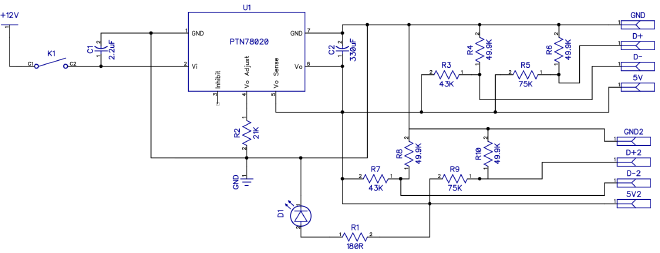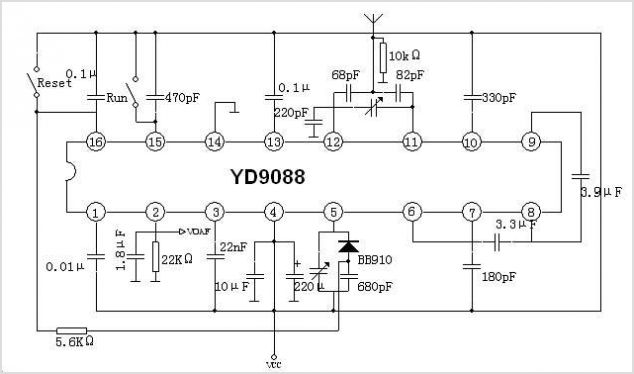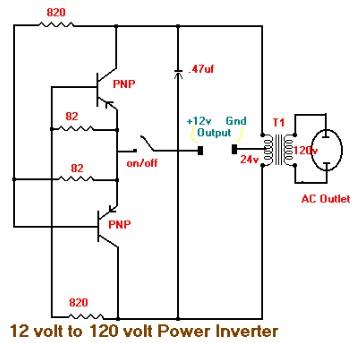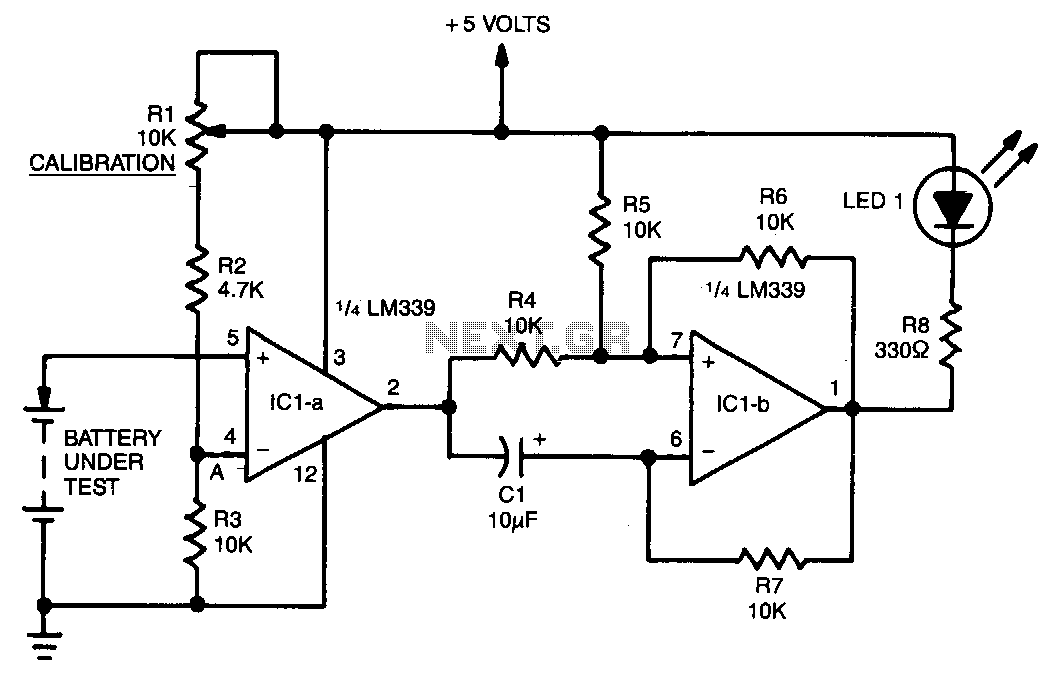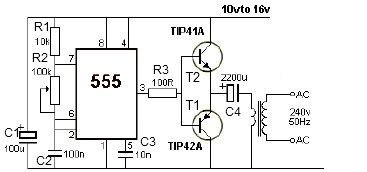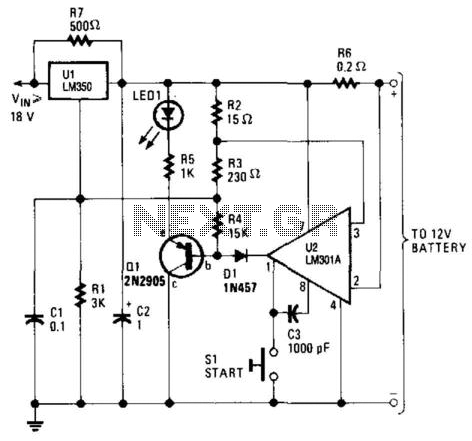
12V Lead Acid Battery Desulphator

Lead-acid batteries frequently experience premature failure due to overcharging, undercharging, deep discharging, and low electrolyte levels. These conditions can lead to the sulfation of the plates, resulting in high internal resistance and eventual battery failure. Typically, this sulfation process is considered irreversible; however, this circuit is purported to reverse the process by applying high-voltage pulses to decompose the lead sulfate compounds. The circuit functions as a high-voltage pulse generator powered directly from the battery in question. In cases of severe sulfation, it may be necessary to connect the battery to a low-power charger, approximately 2A. There are reservations regarding the effectiveness of reversing battery sulfation, but the circuit is shared due to its particular interest. The circuit has been submitted by various sources, leaving the original designer unknown. Additional information is available. The 555 timer is configured as an astable oscillator, with its output frequency determined by resistors R1, R2, and capacitor C2. The output pulses activate the gate of MOSFET Q1, which subsequently charges inductors L1 and L2. At the conclusion of each pulse, Q1 turns off, allowing the inductors to generate a high-voltage, high-current pulse that is applied across the battery through fast-recovery diode D1 and a 100 µF capacitor. The 555 timer is safeguarded from high-voltage pulses by its isolated supply, which includes a 15V zener diode ZD1, a 47 µF capacitor, and a 330-ohm resistor R3.
The circuit operates based on the principle of generating high-voltage pulses to mitigate lead sulfate buildup on the battery plates. The astable multivibrator configuration of the 555 timer continuously generates a square wave output, with the frequency set by the chosen resistor and capacitor values. This output drives the gate of the MOSFET Q1, enabling it to switch on and off rapidly, thus controlling the charging of the inductors L1 and L2.
When Q1 is activated, current flows through the inductors, storing energy in the magnetic field. Once Q1 is turned off, the collapsing magnetic field induces a high-voltage pulse across the inductors. This pulse is directed to the battery through the fast-recovery diode D1, ensuring that the current flows in the correct direction while protecting the circuit from back EMF. The capacitor (100 µF) serves to smooth the output pulse, providing a more stable voltage to the battery.
The inclusion of the zener diode (ZD1) is crucial for protecting the 555 timer from voltage spikes generated during the operation of the circuit. The 47 µF capacitor works in conjunction with the zener diode to filter any high-frequency noise that may affect the stability of the 555 timer operation. The 330-ohm resistor (R3) limits the current flowing into the zener diode, ensuring that it operates within its safe limits.
This circuit provides a potentially innovative approach to addressing sulfation in lead-acid batteries, although the effectiveness of reversing sulfation remains a subject of debate. Proper implementation and safety precautions should be taken into account when working with high-voltage circuits, especially in applications involving lead-acid batteries.Lead acid batteries often fail prematurely due to over-charging, under-charging, deep discharging and low electrolyte level. All of these can lead to sulphation of the plates which leads to high internal resistance and eventual failure.
Normally, this process is regarded as irreversible but this circuit is claimed to reverse the process by applyin g high voltage pulses to break down the lead sulphate compounds. The circuit is essentially a high-voltage pulse generator which is powered directly from the battery in question. If the battery is badly sulphated, it will be necessary to connect it to a low power charger as well, say 2A.
We have strong doubts about whether battery sulphation can be effectively reversed but we are publishing this circuit because the subject is of particular interest. This circuit has been submitted to us from a number of sources so we do not know who is the original designer.
More information can be found at. The 555 timer is connected as an astable oscillator with its output frequency set by R1, R2 and C2. Its output pulses drive the gate of Mosfet Q1 which turns on to charge inductors L1 and L2. At the end of each pulse, Q1 turns off and the inductors develop a high-voltage high-current pulse which is applied across the battery via fast recovery diode D1 and the 100 µF capacitor. The 555 is protected from the high voltage pulses via its isolated supply, by virtue of the 15V zener diode ZD1, the 47 µF capacitor and the 330Oresistor R3.
🔗 External reference
The circuit operates based on the principle of generating high-voltage pulses to mitigate lead sulfate buildup on the battery plates. The astable multivibrator configuration of the 555 timer continuously generates a square wave output, with the frequency set by the chosen resistor and capacitor values. This output drives the gate of the MOSFET Q1, enabling it to switch on and off rapidly, thus controlling the charging of the inductors L1 and L2.
When Q1 is activated, current flows through the inductors, storing energy in the magnetic field. Once Q1 is turned off, the collapsing magnetic field induces a high-voltage pulse across the inductors. This pulse is directed to the battery through the fast-recovery diode D1, ensuring that the current flows in the correct direction while protecting the circuit from back EMF. The capacitor (100 µF) serves to smooth the output pulse, providing a more stable voltage to the battery.
The inclusion of the zener diode (ZD1) is crucial for protecting the 555 timer from voltage spikes generated during the operation of the circuit. The 47 µF capacitor works in conjunction with the zener diode to filter any high-frequency noise that may affect the stability of the 555 timer operation. The 330-ohm resistor (R3) limits the current flowing into the zener diode, ensuring that it operates within its safe limits.
This circuit provides a potentially innovative approach to addressing sulfation in lead-acid batteries, although the effectiveness of reversing sulfation remains a subject of debate. Proper implementation and safety precautions should be taken into account when working with high-voltage circuits, especially in applications involving lead-acid batteries.Lead acid batteries often fail prematurely due to over-charging, under-charging, deep discharging and low electrolyte level. All of these can lead to sulphation of the plates which leads to high internal resistance and eventual failure.
Normally, this process is regarded as irreversible but this circuit is claimed to reverse the process by applyin g high voltage pulses to break down the lead sulphate compounds. The circuit is essentially a high-voltage pulse generator which is powered directly from the battery in question. If the battery is badly sulphated, it will be necessary to connect it to a low power charger as well, say 2A.
We have strong doubts about whether battery sulphation can be effectively reversed but we are publishing this circuit because the subject is of particular interest. This circuit has been submitted to us from a number of sources so we do not know who is the original designer.
More information can be found at. The 555 timer is connected as an astable oscillator with its output frequency set by R1, R2 and C2. Its output pulses drive the gate of Mosfet Q1 which turns on to charge inductors L1 and L2. At the end of each pulse, Q1 turns off and the inductors develop a high-voltage high-current pulse which is applied across the battery via fast recovery diode D1 and the 100 µF capacitor. The 555 is protected from the high voltage pulses via its isolated supply, by virtue of the 15V zener diode ZD1, the 47 µF capacitor and the 330Oresistor R3.
🔗 External reference
